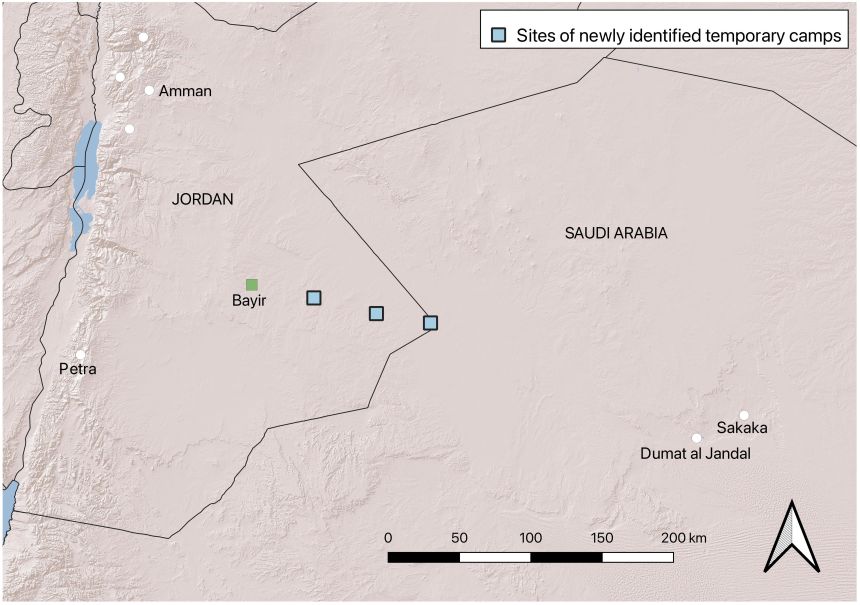‘Spectacular’ new find: Roman military camps in desert found by Oxford archaeologists using Google Earth
Wednesday 26th Apr 2023, 2.49pm
The camps were identified using satellite images. According to the research team, they may have been part of a previously undiscovered Roman military campaign linked to the Roman takeover of the Nabataean Kingdom in AD 106 CE, a civilisation centred on the world-famous city of Petra, located in Jordan.
These camps are a spectacular new find and an important new insight into Roman campaigning in Arabia
Dr Mike Bishop
Dr Michael Fradley, who led the research and first identified the camps on Google Earth, suggests there is little doubt about the date of the camps. He says, ‘We are almost certain they were built by the Roman army, given the typical playing card shape of the enclosures with opposing entrances along each side. The only notable difference between them is that the westernmost camp is significantly larger than the two camps to the east.’
According to Dr Mike Bishop, an expert on the Roman military, ‘These camps are a spectacular new find and an important new insight into Roman campaigning in Arabia. Roman forts and fortresses show how Rome held a province, but temporary camps reveal how they acquired it in the first place.’
 Map showing the location of the Roman camps (Credit: EAMENA).
Map showing the location of the Roman camps (Credit: EAMENA).The camps would have been built by the army as temporary defended stations when they were marching on campaign. Dr Fradley adds, ‘The level of preservation of the camps is really remarkable, particularly as they may have only been used for a matter of days or weeks…They went along a peripheral caravan route linking Bayir and Dûmat al-Jandal. This suggests a strategy to bypass the more used route down the Wadi Sirhan, adding an element of surprise to the attack. It is amazing that we can see this moment in time played out at a landscape scale.’
The level of preservation of the camps is really remarkable, particularly as they may have only been used for a matter of days or weeks…It is amazing that we can see this moment in time played out at a landscape scale
Dr Michael Fradley
Professor Andrew Wilson, a co-author on the paper, says, ‘These marching camps – if we are correct in dating them to the early second century – suggest the Roman annexation of the Nabataean Kingdom following the death of the last king, Rabbel II Soter in AD 106, was not an entirely straightforward affair, and that Rome moved quickly to secure the kingdom.’
Given the distance between each camp is 37 km to 44 km, the team speculate it was too far to be crossed by infantry in a day and were instead built by a cavalry unit who could travel over such barren terrain in a single day, possibly on camels.
On the basis of the distance between the camps there is also a suggestion that another camp may have been located further west at the later Umayyad fort and well station at Bayir.
[It] suggests the Roman annexation of the Nabataean Kingdom…in AD 106, was not an entirely straightforward affair, and that Rome moved quickly to secure the kingdom
Professor Andrew Wilson
The newly discovered camps run in a straight line toward Dûmat al-Jandal in what is now Saudi Arabia, but which was then a settlement in the east of the Nabataean kingdom. It suggests Rome had to force its takeover, whereas the surviving Roman history argues the transfer of power was a peaceful event at the end of the reign of the last Nabataean king.
Archaeologists still need to confirm the date of the camps through investigation on the ground, but there are other questions that need to be answered. Professor Wilson questions, ‘Why does the western camp have twice the capacity of the other two? Did the force split, and if so, where did the other half go? Was it half wiped out in a battle, or did they remain in the western camp to resupply the other camps with water?’
The camps were identified by the Endangered Archaeology in the Middle East and North Africa project (EAMENA), and were later photographed by the Aerial Archaeology in Jordan project (APAAME).
The research is supported by the Arcadia Fund. The full paper can be seen here https://www.cambridge.org/core/journals/antiquity/article/lost-campaign-new-evidence-of-roman-temporary-camps-in-northern-arabia/538421A1D1F89C6EA23F1B757D08CB91

